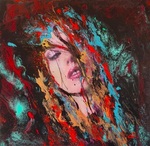|
|
|
Learn more about Visual ArtsA Explorer
Visual Arts Explorer is a revolutionary tool that allows art lovers, gallery owners and art commissioners to find with the magic of a click the artists with the creative expression and sensitivity they are looking for.
It also allows independent artists to create their own roster of art lovers/experts who showed interest in their work, and store their contact information for invitations to future exhibitions.
Visual Arts Explorer is the perfect liaison between the artist and his public.
Are you into abstract art? Do you favor raw art?
With just a couple of clicks, Virtual Arts Explorer evaluates your artistic preferences and introduces you to artists whose talent matches what you are looking for. Make your selection and save it in your free account.
Enjoy your visit !
|
|
You are an artist
Visual Arts Explorer is a revolutionary tool that allows art lovers, gallery owners and art commissioners to find with the magic of a click the artists with the creative expression and sensitivity they are looking for.
It also allows independent artists to create their own roster of art lovers/experts who showed interest in their work, and store their contact information for invitations to future exhibitions.
Vision Arts Explorer is the perfect liaison between the artist and his public.
If you are an artist and wish to know more about joining Visual Arts Explorer and setting up your own roster of gallery owners and collectors, please fill out and submit the fields below. There is no obligation on your part.
This information is collected for the sole purpose of sending you an email containing registration requirements to this website. If you have questions concerning the use of your personal information or wish to modify your contact details, please contact contact@active-leads.com
|
|
PFAADT RUFFENACH Aurélie - Lady Poppies
https://www.aurelie-pfaadt.com
|
| Classification : A280-B210-B200-C130-C180-D110-D130 The classification provides four or more codes placed on four axis (A - formalism, B - matériality, C - involvement body/mind, D - communication). These codes are positionning the artist in the art history.
A axis : FORMALISMWhen looking at the work, what type of formalisation first strikes the eye? Is it more abstract or more figurative, etc ? (on a scale from more "immaterial" to more "realist"). A280 : Figures Imaginary The unconscious generally rather abstract interior spaces. But rising out of the abstract, elements of the imaginary world can crystallize into pre-figurative shapes (Masson, Mirò, Arshile Gorky, …).
B axis : MATERIALITYHow does the materiality of what is shown come across? (on a scale from more "immaterial" to more "real"). B210 : Materiality in painting, but also with all other materials with the following possibilities: Structured with materials predominant their thickness, composition or the way they are worked as structures (the way they are "built up") are here the most important aspect (Eugène Leroy, Bertrand Lavier, ...). B200 : Materiality in painting, but also with all other materials with the following possibilities: Structured with colours predominant with their intrinsic or symbolic strength, (Monory's "blues", G.Fromanger's "reds") historical or social meaning etc., and their structuring, the colours here are the most important (Jules Olitsky, Peter Halley, ...).
C axis : INVOLVEMENT BODY/ MINDWith what body:mind ratio does the artist enter into his work? Classify from the most "intellectual" (e.g."Concept Art"...) to the most "physical" (e.g. "Body Art", ...). C130 : towards the intellectual side/ the essence of things inward looking work chiefly oriented towards: l'introspective inner landscapes, emotions, feelings (Arpad Szenes, ...), serenity (Yves Klein's "Monochromes", ...), equilibrium ("mandalas" of Augustin Lesage or Adolf Wölfli, ...), memory (Boltenski "boxes", ...). C180 : tending towards the corporeal / the senses via expression with a frank sensuality, or even openly sexual either literal (Courbet's "Origin of the world", Lucian Freud, John Kacere, P. Klossowki, David Salle, Gilbert and George, ...), - symbolic (Paul Armand Gette, Andreas Serrano, ...), - humorous (Gilles Barbier "cerveau", Boyd Webb "the globe" , ...), - or "realist" (certain "Body-artists" such as Otto Muehl, Paul Mc Carthy's "installations" , Zoran Naskovski's videos, ...), ...
D axis : COMMUNICATIONDoes the artist have the deliberate intention to convey a message of any sort through his work? (classified from the most "mystical" to the most "worldly"). D110 : via what is meant with various spiritual or less marked religious influences (from Barnett Newman to Mark Rothko, from Roman Opalka to Arnulf Rainer, ...). D130 : via what is meaningful based on the idea that work on what symbolizes forms an intentional message in itself (for example: Daniel Dezeuze's "Stretchers", etc., etc., ...). by variations in execution seriality, multiplication (Claude Viallat, Niele Toroni, "figurines" by Antony Gormley, ...), accumulation or compression (J. Chamberlain, Arman, César, ...), subtleties and variability of the material (Rober Ryman's "Whites"; dissolutions of "matter / life" by Roman Opalka or by On Kawara; Gilberto Zorio, ...). | |  |
|














